Tribological Behaviour of Graphene Nanoplatelets as Additive in Pongamia Oil
Abstract
:1. Introduction
2. Experimental Details and Procedure
2.1. Preparation of Graphene-Based Nanolubricant
2.2. Tribological Experimental Test
Friction and Wear Measurement
2.3. Surface Analysis
3. Results and Discussion
3.1. Friction and Wear Behaviour
3.2. Worn Surface Analysis
4. Conclusions
Author Contributions
Funding
Institutional Review Board Statement
Informed Consent Statement
Data Availability Statement
Acknowledgments
Conflicts of Interest
References
- Ssempebwa, J.C.; Carpenter, D.O. The generation, use and disposal of waste crankcase oil in developing countries: A case for kampala district, Uganda. J. Hazard. Mater. 2009, 161, 835–841. [Google Scholar] [CrossRef] [PubMed] [Green Version]
- Lathi, P.S.; Mattiasson, B. Green approach for the preparation of biodegradable lubricant base stock from epoxidized vegetable oil. Appl. Catal. B Environ. 2007, 69, 207–212. [Google Scholar] [CrossRef]
- Mobarak, H.; Mohamad, E.N.; Masjuki, H.; Kalam, A.; Al Mahmud, K.; Habibullah, M.; Ashraful, A. The prospects of biolubricants as alternatives in automotive applications. Renew. Sustain. Energy Rev. 2014, 33, 34–43. [Google Scholar] [CrossRef]
- Wagner, H.; Luther, R.; Mang, T. Lubricant base fluids based on renewable raw materials: Their catalytic manufacture and modification. Appl. Catal. A Gen. 2001, 221, 429–442. [Google Scholar] [CrossRef]
- Alves, S.M.; Barros, B.S.; Trajano, M.F.; Ribeiro, K.S.B.; Moura, E. Tribological behavior of vegetable oil-based lubricants with nanoparticles of oxides in boundary lubrication conditions. Tribol. Int. 2013, 65, 28–36. [Google Scholar] [CrossRef]
- Uflyand, I.E.; Zhinzhilo, V.A.; Burlakova, V.E. Metal-containing nanomaterials as lubricant additives: State-of-the-art and future development. Friction 2019, 7, 93–116. [Google Scholar] [CrossRef] [Green Version]
- Tang, Z.; Li, S. A review of recent developments of friction modifiers for liquid lubricants (2007–present). Curr. Opin. Solid State Mater. Sci. 2014, 18, 119–139. [Google Scholar] [CrossRef]
- Bahadar, H.; Maqbool, F.; Niaz, K.; Abdollahi, M. Toxicity of nanoparticles and an overview of current experimental models. Iran. Biomed. J. 2016, 20, 1–11. [Google Scholar]
- Peña-Parás, L.; Maldonado-Cortés, D.; Taha-Tijerina, J. Eco-friendly nanoparticle additives for lubricants and their tribological characterization. In Handbook of Ecomaterials; Martínez, L., Kharissova, O., Kharisov, B., Eds.; Springer: Cham, Switzerland, 2019; pp. 3247–3267. [Google Scholar]
- Gulzar, M.; Masjuki, H.H.; Kalam, A.; Varman, M.; Zulkifli, N.W.M.; Mufti, R.A.; Zahid, R.; Yunus, R. Dispersion stability and tribological characteristics of TiO2/SiO2 Nanocomposite-Enriched Biobased Lubricant. Tribol. Trans. 2017, 60, 670–680. [Google Scholar] [CrossRef]
- Eswaraiah, V.; Sankaranarayanan, V.; Ramaprabhu, S. Graphene-based engine oil nanofluids for tribological applications. ACS Appl. Mater. Interfaces 2011, 3, 4221–4227. [Google Scholar] [CrossRef]
- Zhao, J.; Mao, J.; Li, Y.; He, Y.; Luo, J. Friction-induced nano-structural evolution of graphene as a lubrication additive. Appl. Surf. Sci. 2018, 434, 21–27. [Google Scholar] [CrossRef]
- Lin, J.; Wang, L.; Chen, G. Modification of graphene platelets and their tribological properties as a lubricant additive. Tribol. Lett. 2011, 41, 209–215. [Google Scholar] [CrossRef]
- Taaber, T.; Enok, A.E.; Joost, U.; Oras, S.; Järvekülg, M.; Lohmus, R.; Maeorg, U.; Saal, K. Tribological properties of protic ionic liquid and functionalized copper oxide nanoparticles as additives to base oil. Mechanika 2015, 21, 148–153. [Google Scholar] [CrossRef] [Green Version]
- Yu, W.; Xie, H. A review on nanofluids: Preparation, stability mechanisms, and applications. J. Nanomater. 2012, 2012, 1–17. [Google Scholar] [CrossRef] [Green Version]
- Dai, W.; Kheireddin, B.; Gao, H.; Liang, H. Roles of nanoparticles in oil lubrication. Tribol. Int. 2016, 102, 88–98. [Google Scholar] [CrossRef]
- Viesca, J.L. Hernández Battez, A.; González, R.; Chou, R.; Cabello, J.J. Antiwear properties of carbon-coated copper nanoparticles used as an additive to a polyalphaolefin. Tribol. Int. 2011, 44, 829–833. [Google Scholar] [CrossRef]
- Wu, H.; Zhao, J.; Cheng, X.; Xia, W.; He, A.; Yun, J.-H.; Huang, S.; Wang, L.; Huang, H.; Jiao, S.; et al. Friction and wear characteristics of TiO2 nano-additive water-based lubricant on ferritic stainless steel. Tribol. Int. 2018, 117, 24–38. [Google Scholar] [CrossRef] [Green Version]
- Wang, L.; Gong, P.; Li, W.; Luo, T.; Cao, B. Mono-dispersed Ag/graphene nanocomposite as lubricant additive to reduce friction and wear. Tribol. Int. 2020, 146, 106228. [Google Scholar] [CrossRef]
- Yadgarov, L.; Petrone, V.; Rosentsveig, R.; Feldman, Y.; Tenne, R.; Senatore, A. Tribological studies of rhenium doped fullerene-like MoS2 nanoparticles in boundary, mixed and elasto-hydrodynamic lubrication conditions. Wear 2013, 297, 1103–1110. [Google Scholar] [CrossRef]
- Meng, Y.; Su, F.; Chen, Y. Supercritical fluid synthesis and tribological applications of silver nanoparticle-decorated graphene in engine oil nanofluid. Sci. Rep. 2016, 6, 31246. [Google Scholar] [CrossRef] [Green Version]
- Wang, X.; Yin, Y.; Zhang, G.; Wang, W.; Zhao, K. Study on Antiwear and repairing performances about mass of nano-copper lubricating additives to 45 steel. Phys. Procedia 2013, 50, 466–472. [Google Scholar] [CrossRef] [Green Version]
- Rajan, B.S.; Sai Balaji, M.A.; Mohamed Aslam Noorani, A.B. Tribological performance of graphene/graphite filled phenolic composites—a comparative study. Compos. Commun. 2019, 15, 34–39. [Google Scholar]
- Koshy, C.P.; Rajendrakumar, P.K.; Thottackkad, M.V. Evaluation of the tribological and thermo-physical properties of coconut oil added with MoS2 nanoparticles at elevated temperatures. Wear 2015, 288–308, 330–331. [Google Scholar] [CrossRef]
- Tevet, O.; Von-Huth, P.; Popovitz-Biro, R.; Rosentsveig, R.; Wagner, H.D.; Tenne, R. Friction mechanism of individual multilayered nanoparticles. Proc. Natl. Acad. Sci. USA 2011, 108, 19901–19906. [Google Scholar] [CrossRef] [PubMed] [Green Version]
- Jason, Y.J.J.; How, H.G.; Teoh, Y.H.; Chuah, H.G. A study on the tribological performance of nanolubricants. Processes 2020, 8, 1372. [Google Scholar] [CrossRef]
- Azman, N.F.; Samion, S.; Sot, M.N.H.M. Investigation of tribological properties of CuO/palm oil nanolubricant using pin-on-disc tribotester. Green Mater. 2018, 6, 30–37. [Google Scholar] [CrossRef] [Green Version]
- Wang, Z.; Ren, R.; Song, H.; Jia, X. Improved tribological properties of the synthesized copper/carbon nanotube nanocomposites for rapeseed oil-based additives. Appl. Surf. Sci. 2018, 428, 630–639. [Google Scholar] [CrossRef]
- Rajubhai, V.H.; Singh, Y.; Suthar, K.; Surana, A.R. Friction and wear behavior of Al-7% Si alloy pin under pongamia oil with copper nanoparticles as additives. Mater. Today Proc. 2020, 25, 695–698. [Google Scholar] [CrossRef]
- Abadi, A.; Maynard, H.; Arpiwi, N.L.; Stucley, C.; Bartle, J.; Giles, R. Economics of oil production from pongamia (Millettia pinnata) for biofuel in australia. BioEnergy Res. 2016, 9, 874–883. [Google Scholar] [CrossRef]
- ASTM International. ASTM D4172-20. Standard Test Method for Wear Preventive Characteristics of Lubricating Fluid (Four-Ball Method); ASTM International: West Conshohocken, PA, USA, 2020. [Google Scholar]
- Philip, J.T.; Koshy, C.P.; Mathew, M.D.; Kuriachen, B. Tribological characteristic evaluation of coconut oil dispersed with surfactant modified ceria-zirconia hybrid nanoparticles. Tribol. Mater. Surf. Interfaces 2019, 13, 197–214. [Google Scholar] [CrossRef]
- Zulkifli, N.W.M.; Kalam, M.A.; Masjuki, H.H.; Yunus, R. Experimental analysis of tribological properties of bio-lubricant with nanoparticle additive. Procedia Eng. 2013, 68, 152–157. [Google Scholar] [CrossRef] [Green Version]
- Azman, S.S.N.; Zulkifli, N.W.M.; Masjuki, H.; Gulzar, M.; Zahid, R. Study of tribological properties of lubricating oil blend added with graphene nanoplatelets. J. Mater. Res. 2016, 31, 1932–1938. [Google Scholar] [CrossRef]
- Rabaso, P.; Ville, F.; Dassenoy, F.; Diaby, M.; Afanasiev, P.; Cavoret, J.; Vacher, B.; Le Mogne, T. Boundary lubrication: Influence of the size and structure of inorganic fullerene-like MoS2 nanoparticles on friction and wear reduction. Wear 2014, 320, 161–178. [Google Scholar] [CrossRef]
- Gulzar, M.; Masjuki, H.H.; Kalam, A.; Varman, M.; Zulkifli, N.W.M.; Mufti, R.A.; Zahid, R. Tribological performance of nanoparticles as lubricating oil additives. J. Nanopart. Res. 2016, 18, 1–25. [Google Scholar] [CrossRef]
- ASTM International. ASTM D4052-18a. Standard Test Method for Density, Relative Density, and API Gravity of Liquids by Digital Density Meter; ASTM International: West Conshohocken, PA, USA, 2018. [Google Scholar]
- ASTM International. ASTM D445-21. Standard Test Method for Kinematic Viscosity of Transparent and Opaque Liquids (and Calculation of Dynamic Viscosity); ASTM International: West Conshohocken, PA, USA, 2021. [Google Scholar]
- ASTM International. ASTM D2270-10(2016). Standard Practice for Calculating Viscosity Index from Kinematic Viscosity at 40 °C and 100 °C; ASTM International: West Conshohocken, PA, USA, 2016. [Google Scholar]
- ASTM International. ASTM D97-17b. Standard Test Method for Pour Point of Petroleum Product; ASTM International: West Conshohocken, PA, USA, 2017. [Google Scholar]
- ASTM International. ASTM D93-20. Standard Test Methods for Flash Point by Pensky-Martens Closed Cup Tester; ASTM International: West Conshohocken, PA, USA, 2020. [Google Scholar]
- Fazal, M.; Haseeb, A.; Masjuki, H. Investigation of friction and wear characteristics of palm biodiesel. Energy Convers. Manag. 2013, 67, 251–256. [Google Scholar] [CrossRef]
- Wang, S.; Chen, D.; Chen, Y.; Zhu, K. Dispersion stability and tribological properties of additives introduced by ultrasonic and microwave assisted ball milling in oil. RSC Adv. 2020, 10, 25177–25185. [Google Scholar] [CrossRef]
- Mahipal, D.; Jayadas, N.H. Evaluation of karanja oil (pongamia pinnata) as a novel base oil for bio degradable lubricants with nano zno as antiwear additive. IJRAR Int. J. Res. Anal. Rev. 2019, 6, 1–8. [Google Scholar]
- Attari, H.; Derakhshanfard, F.; Darvanjooghi, M.H.K. Effect of temperature and mass fraction on viscosity of crude oil-based nanofluids containing oxide nanoparticles. Int. Commun. Heat Mass Transf. 2017, 82, 103–113. [Google Scholar] [CrossRef]
- Blau, P.J. Interpretations of the friction and wear break-in behavior of metals in sliding contact. Wear 1981, 71, 29–43. [Google Scholar] [CrossRef]
- Rabinowicz, E. Lubrication of Metal Surfaces by Oxide Films. A S L E Trans. 1967, 10, 400–407. [Google Scholar] [CrossRef]
- Moshkovith, A.; Perfiliev, V.; Lapsker, I.; Fleischer, N.; Tenne, R.; Rapoport, L. Friction of fullerene-like WS2 nanoparticles: Effect of agglomeration. Tribol. Lett. 2006, 24, 225–228. [Google Scholar] [CrossRef]
- Wan, Q.; Jin, Y.; Sun, P.; Ding, Y. Rheological and tribological behaviour of lubricating oils containing platelet MoS2 nanoparticles. J. Nanopart. Res. 2014, 16, 2386. [Google Scholar] [CrossRef]
- Bahari, A.; Lewis, R.; Slatter, T. Friction and wear response of vegetable oils and their blends with mineral engine oil in a reciprocating sliding contact at severe contact conditions. Proc. Inst. Mech. Eng. Part J J. Eng. Tribol. 2017, 232, 244–258. [Google Scholar] [CrossRef] [Green Version]
- Lee, K.; Hwang, Y.; Cheong, S.; Choi, Y.; Kwon, L.; Lee, J.; Kim, S.H. Understanding the role of nanoparticles in nano-oil lubrication. Tribol. Lett. 2009, 35, 127–131. [Google Scholar] [CrossRef]
- Peng, D.; Kang, Y.; Hwang, R.; Shyr, S.; Chang, Y. Tribological properties of diamond and SiO2 nanoparticles added in paraffin. Tribol. Int. 2009, 42, 911–917. [Google Scholar] [CrossRef]
- Huang, H.; Tu, J.; Gan, L.; Li, C. An investigation on tribological properties of graphite nanosheets as oil additive. Wear 2006, 261, 140–144. [Google Scholar] [CrossRef]
- Zhao, J.; He, Y.; Wang, Y.; Wang, W.; Yan, L.; Luo, J. An investigation on the tribological properties of multilayer graphene and MoS2 nanosheets as additives used in hydraulic applications. Tribol. Int. 2016, 97, 14–20. [Google Scholar] [CrossRef]
- Syahrullail, S.; Kamitani, S.; Shakirin, A. Performance of vegetable oil as lubricant in extreme pressure condition. Procedia Eng. 2013, 68, 172–177. [Google Scholar] [CrossRef]

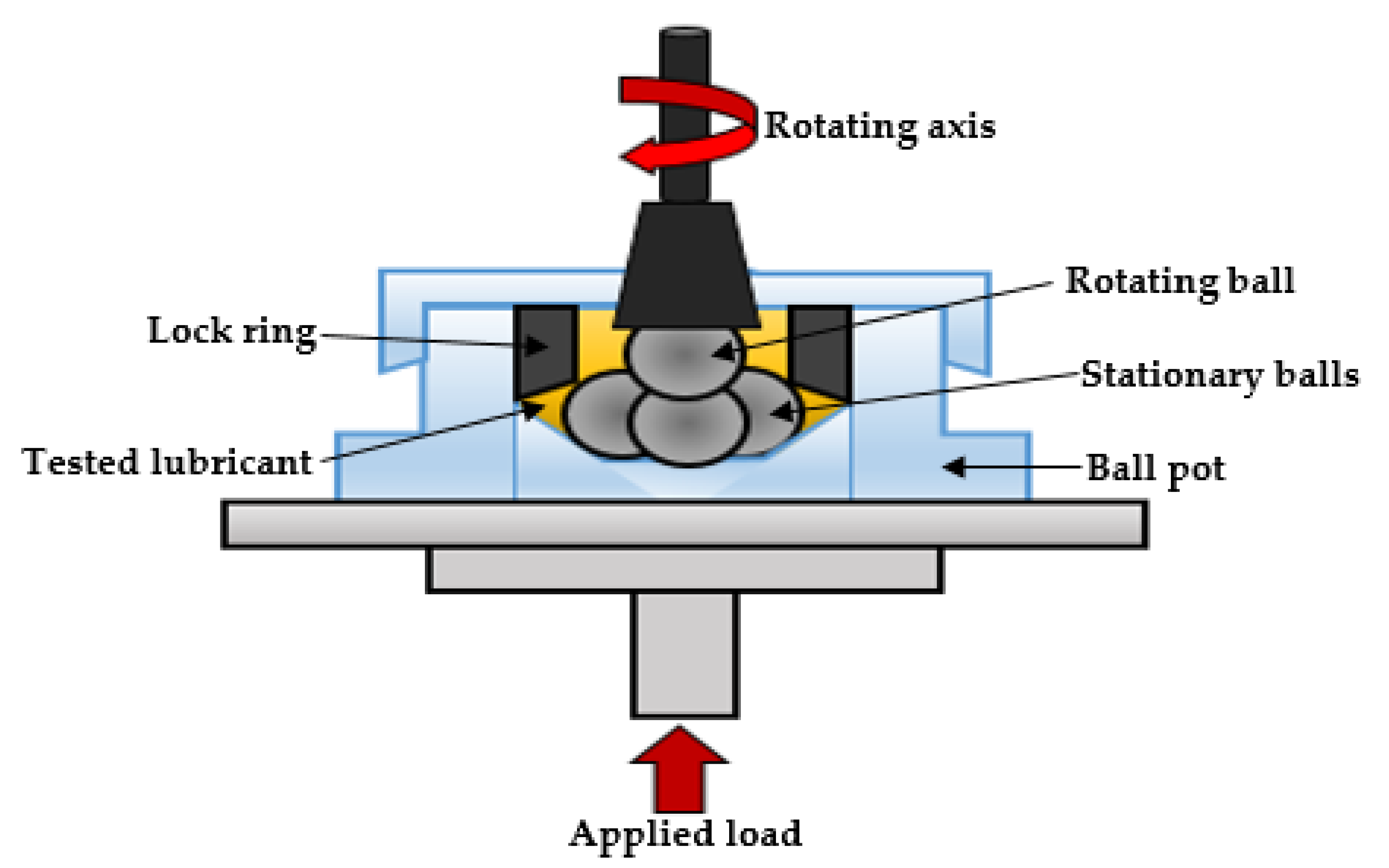

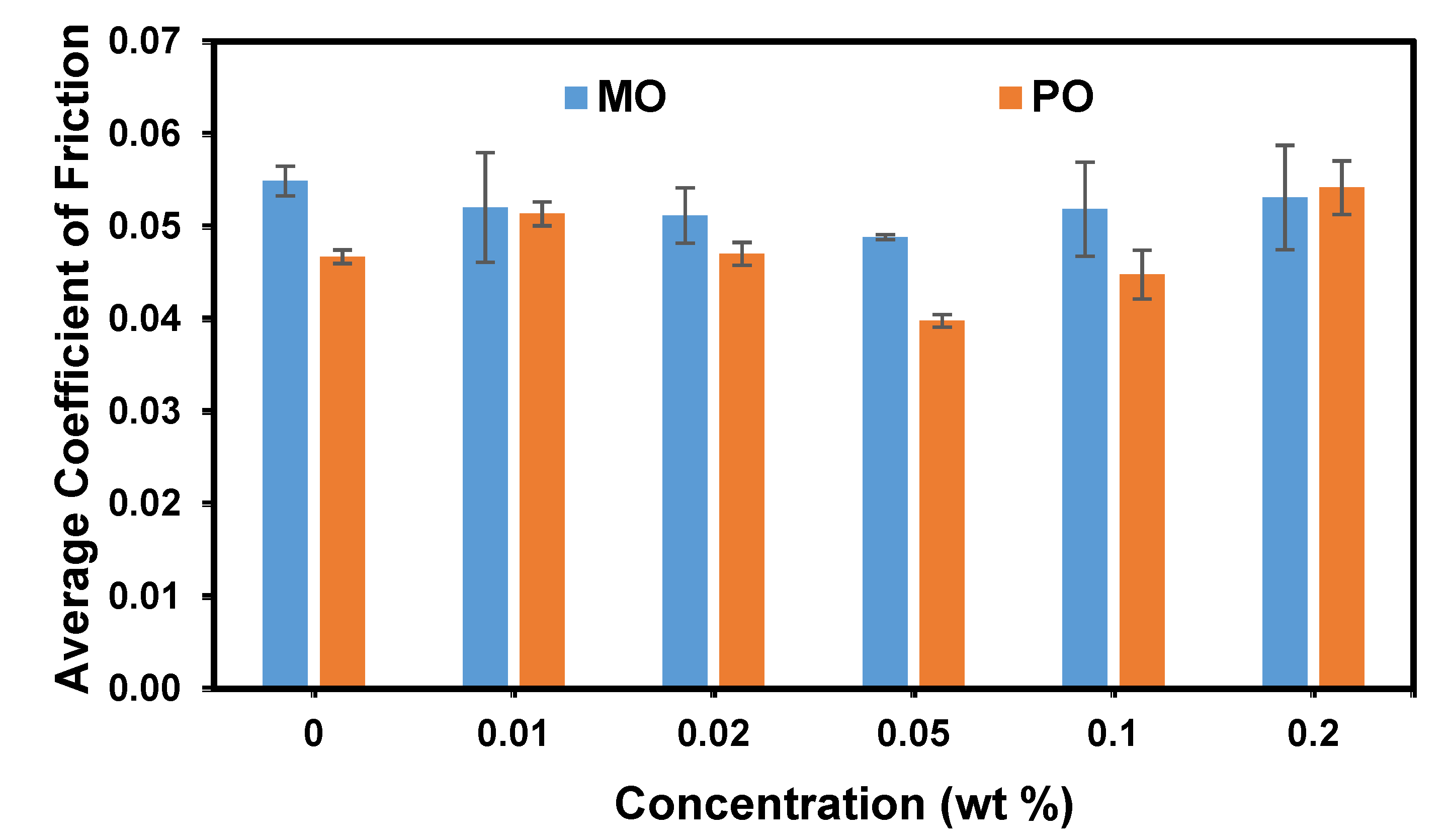
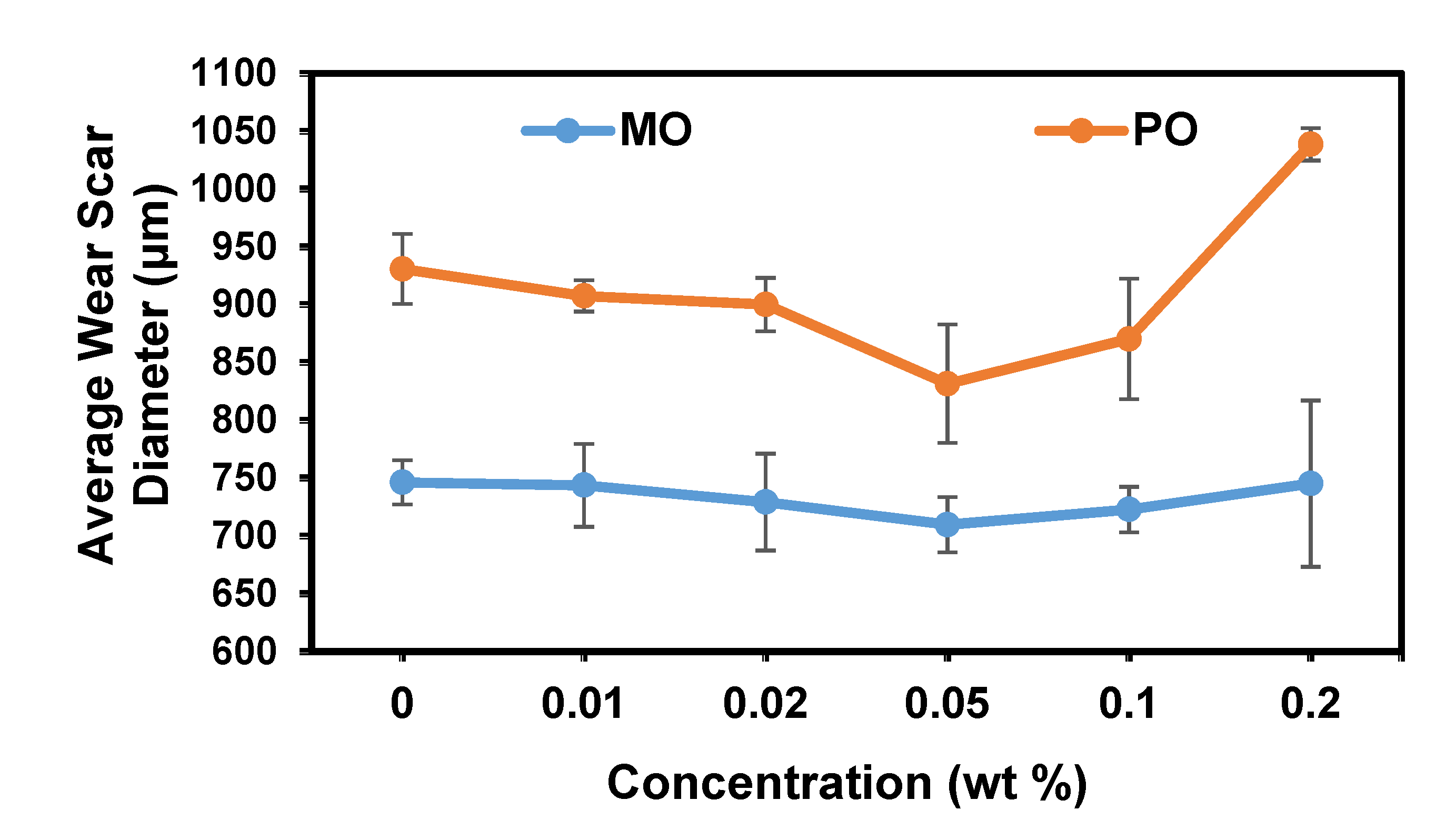
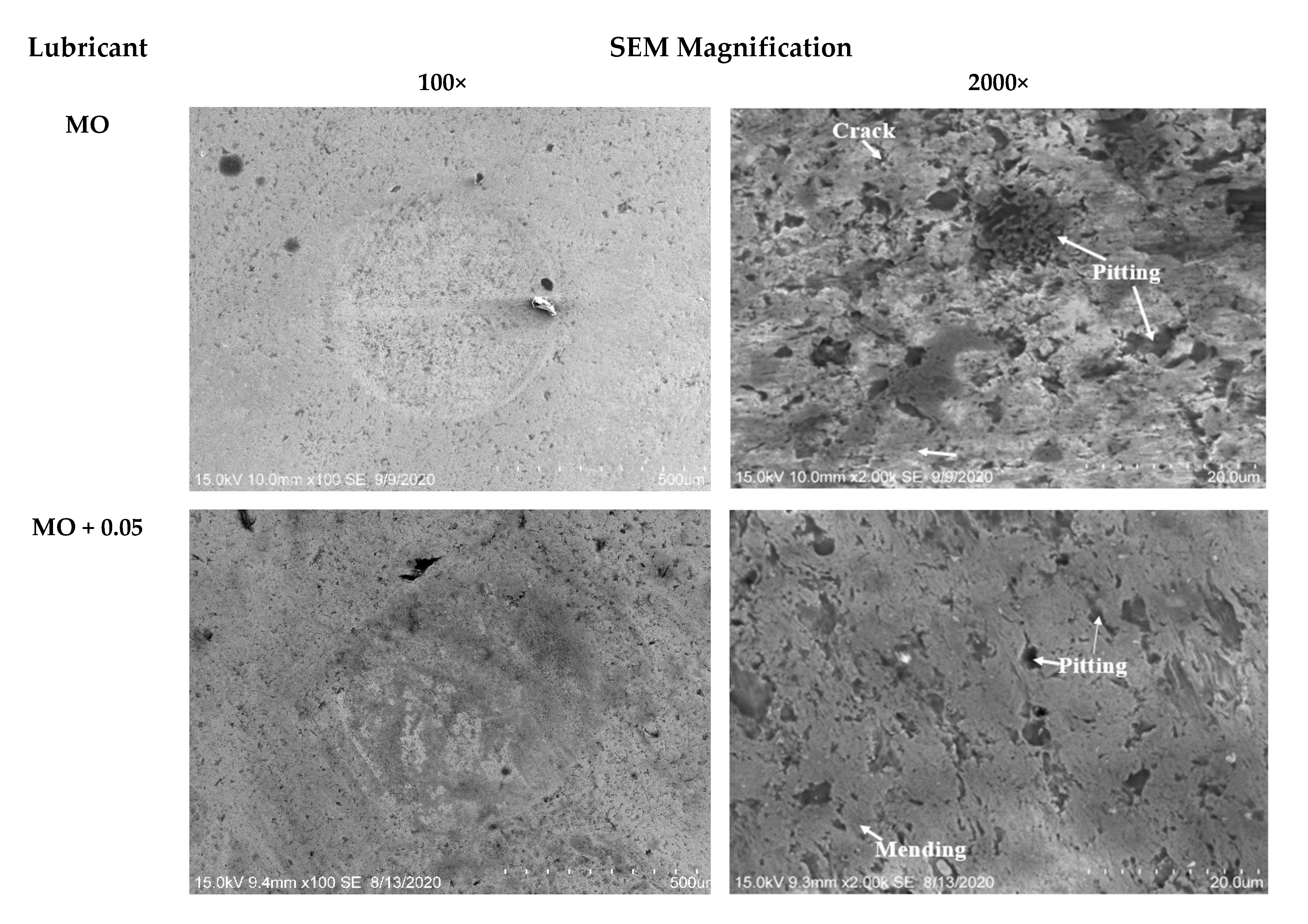
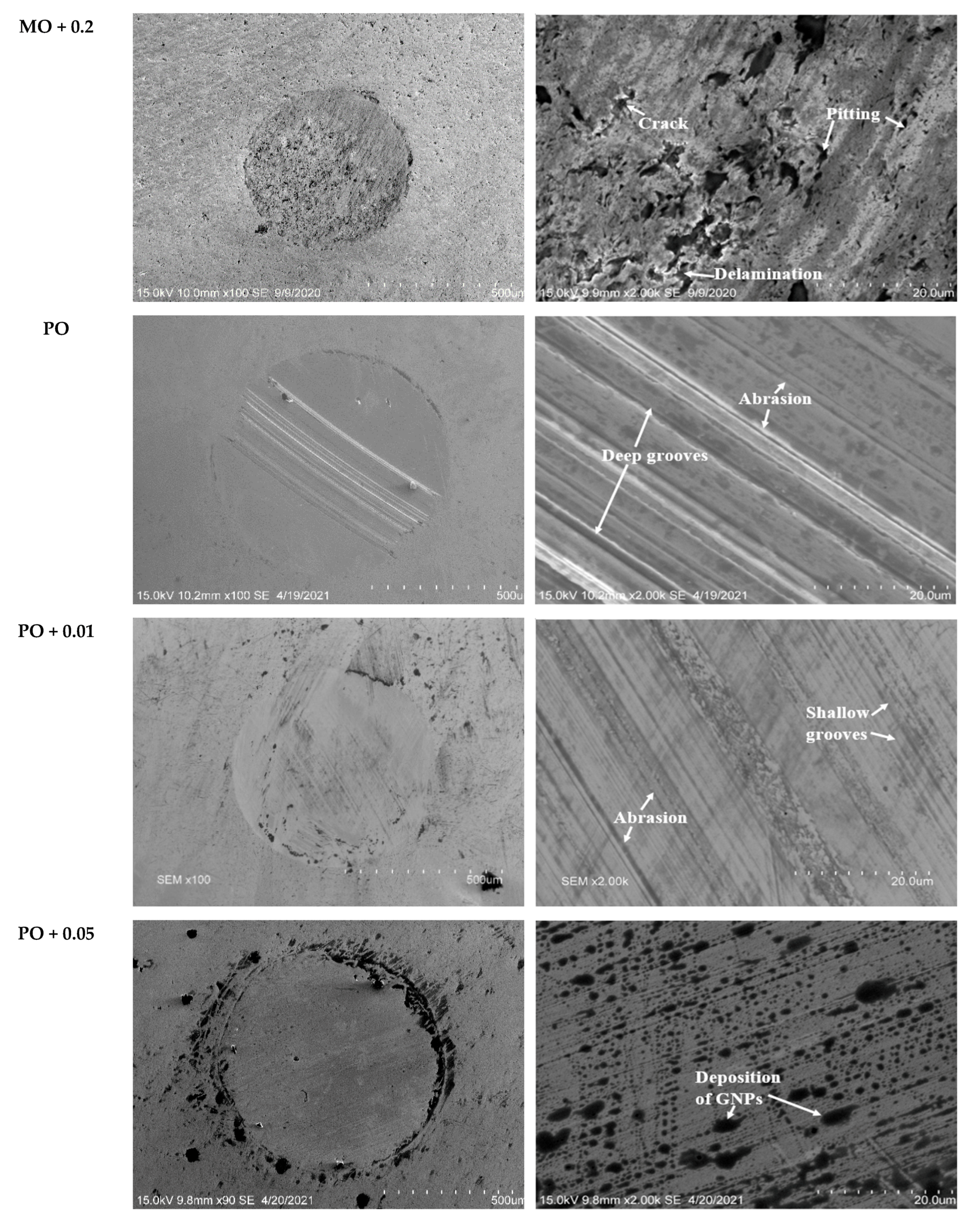

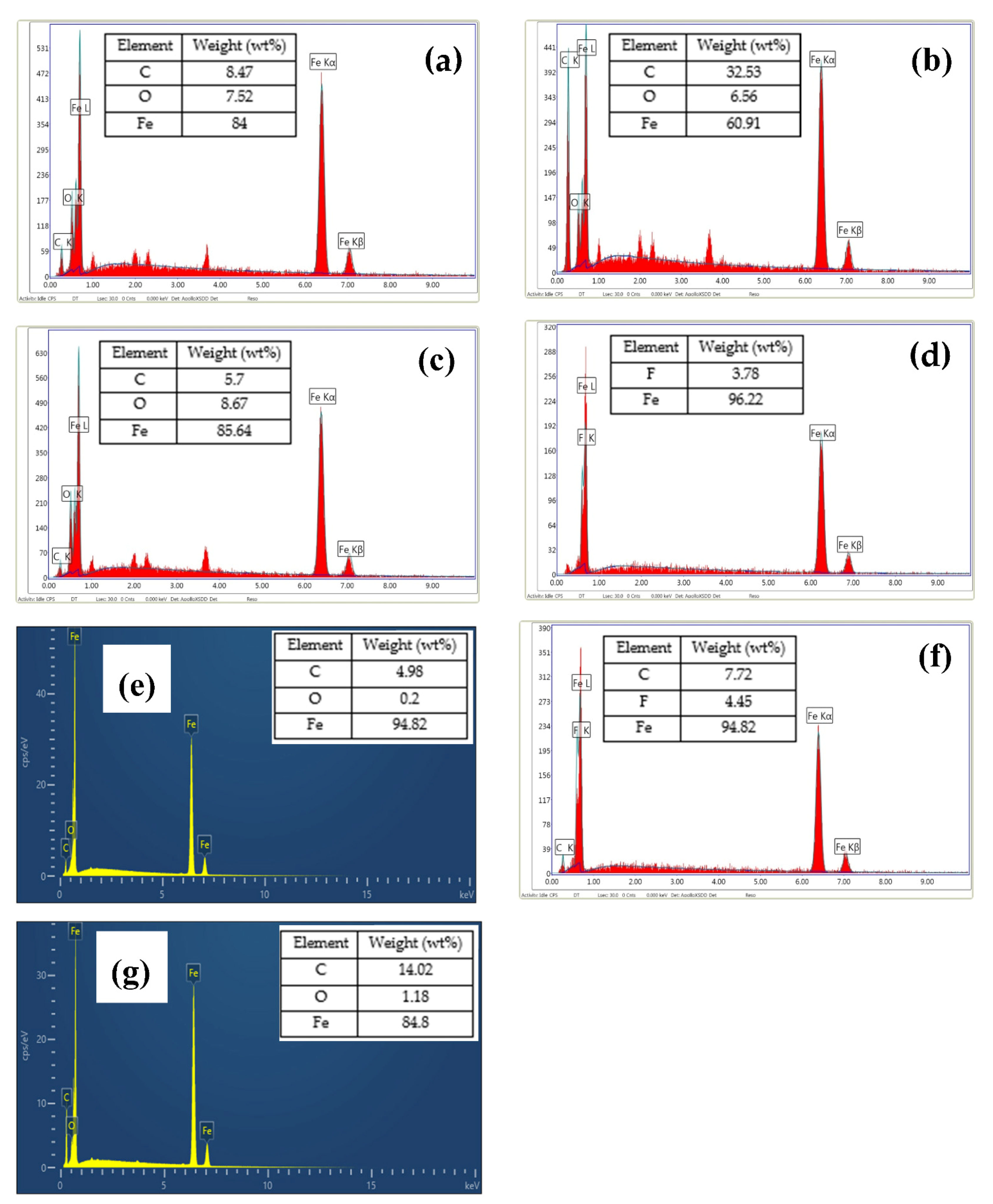
| Base Oil | Nanoparticles | Concentration (wt %) | References |
|---|---|---|---|
| Palm-oil-based TMP ester | TiO2/SiO2 | 0.25–1 | [10] |
| Palm kernel oil | CuO | 0.34 | [27] |
| Rapeseed oil | Cu, CNTs, Cu/CNTs, Cu/CNTs/PDA | 0.20 | [28] |
| Pongamia oil | Cu | 0.025–0.1 | [29] |
| Coconut oil | Ce/Zr | 0.5, 0.62 and 1 | [32] |
| Palm-oil-based TMP ester | TiO2 | 0.1 | [33] |
| Palm-oil-based TMP ester | GNPs | 0.01–3 | [34] |
| Properties | Standard Method | Test Lubricant | |
|---|---|---|---|
| MO | PO | ||
| Density @ 15 °C (g/cm3) | ASTM D4052 [37] | 0.87 | 0.94 |
| Kinematic viscosity @ 40 °C (mm2/s) | ASTM D445 [38] | 105 | 38.80 |
| Kinematic viscosity @ 100 °C (mm2/s) | ASTM D445 | 13.90 | - |
| Viscosity index | ASTM 2270 [39] | 130 | - |
| Pour point (°C) | ASTM D97 [40] | −36 | −4 |
| Flash point (°C) | ASTM D93 [41] | 203 | 212 |
| Properties | Description |
|---|---|
| Appearance (colour) | Black |
| Physical form | Powder |
| Relative density (g /cm3) | 2.0–2.25 |
| Thickness (nm) | Few |
| Particle size (µm) | <2 |
| Surface area (m2/g) | 500 |
| Bulk density (g/cm3) | 0.2–0.4 |
| Test Conditions | Value |
|---|---|
| Load (kg) | 40 ± 0.3 |
| Speed (rpm) | 1200 ± 2 |
| Test temperature (°C) | 75 ± 2 |
| Test duration (min) | 60 |
| Addition of concentration of graphene (wt %) | 0.01, 0.02, 0.05, 0.1 and 0.2 |
| Ball material | AISI 52100 |
| Ball composition | 0.95–1.1% C; 1.3–1.6% Cr; balance Fe |
| Ball diameter (mm) | 12.7 |
| Ball hardness (HRC) | 64–66 |
| Lubricants | COF Values | Standard Deviation, COF | WSD Values (μm) | Standard Deviation, WSD (μm) |
|---|---|---|---|---|
| MO | 0.055 | 0.0016 | 746.2 | 19.0 |
| MO + 0.01 | 0.052 | 0.0059 | 743.7 | 35.8 |
| MO + 0.02 | 0.051 | 0.0030 | 729.2 | 41.8 |
| MO + 0.05 | 0.049 | 0.0003 | 709.7 | 23.8 |
| MO + 0.1 | 0.052 | 0.0051 | 722.7 | 19.6 |
| MO + 0.2 | 0.053 | 0.0057 | 745.2 | 71.8 |
| PO | 0.047 | 0.0007 | 930.8 | 30.3 |
| PO + 0.01 | 0.051 | 0.0013 | 907.5 | 13.6 |
| PO + 0.02 | 0.047 | 0.0012 | 900.0 | 23.1 |
| PO + 0.05 | 0.040 | 0.0007 | 831.4 | 51.2 |
| PO + 0.1 | 0.045 | 0.0026 | 870.2 | 52.1 |
| PO + 0.2 | 0.054 | 0.0029 | 1038.6 | 13.9 |
Publisher’s Note: MDPI stays neutral with regard to jurisdictional claims in published maps and institutional affiliations. |
© 2021 by the authors. Licensee MDPI, Basel, Switzerland. This article is an open access article distributed under the terms and conditions of the Creative Commons Attribution (CC BY) license (https://creativecommons.org/licenses/by/4.0/).
Share and Cite
Jason, Y.J.J.; How, H.G.; Teoh, Y.H.; Sher, F.; Chuah, H.G.; Teh, J.S. Tribological Behaviour of Graphene Nanoplatelets as Additive in Pongamia Oil. Coatings 2021, 11, 732. https://doi.org/10.3390/coatings11060732
Jason YJJ, How HG, Teoh YH, Sher F, Chuah HG, Teh JS. Tribological Behaviour of Graphene Nanoplatelets as Additive in Pongamia Oil. Coatings. 2021; 11(6):732. https://doi.org/10.3390/coatings11060732
Chicago/Turabian StyleJason, Yeoh Jun Jie, Heoy Geok How, Yew Heng Teoh, Farooq Sher, Hun Guan Chuah, and Jun Sheng Teh. 2021. "Tribological Behaviour of Graphene Nanoplatelets as Additive in Pongamia Oil" Coatings 11, no. 6: 732. https://doi.org/10.3390/coatings11060732






